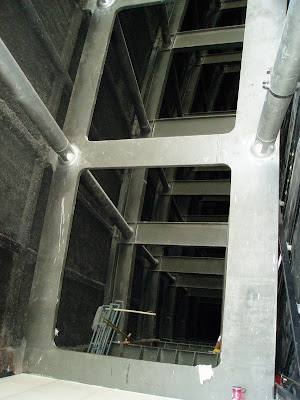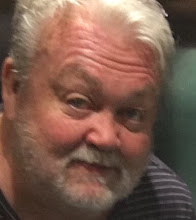18: beijing bulletin

i made a quick trip to beijing a few weekends in advance of the olympic crowds to check out all the new buildings with shanghai architect and friend, paul rice.
it seemed every farmer in northern china was at work there, planting impatiens or tending flowerbeds and shrubbery, everywhere you looked. normally you don't see much grass in china- people prefer edible produce over decorative lawns- but for all the foreigners, they were rolling out the green carpet. never have i seen beijing so clean and inviting; the weather was fantastic, the skies sparkling and blue like i've rarely seen before. even the residents looked scrubbed-up and more and cheerful, eager to speak some english and "assist" you, whether you wanted it or not.
the olympic park was already locked down, with increasing security. where earlier, one could stroll past the guards and get up close and personal with construction crews, international television crews setting up equipment were protected by rings of armed soldiers. batteries of ant-aircraft missles around the birds nest had yet to be camouflaged, and the roof of the nest itself had sprouted some sort of inflatable, shrouded carbuncle that (if not espn or nbc) i assumed was military in nature, too; turns out it was the flame cauldron, under wraps until the opening ceremony.
the collective sense of humor was sharp as ever, and taxis were pedal-to-the-metal to get you to the other beijing destinations that a few months ago, they knew nothing about. now they even have their own nicknames for the biggest stars: first is "big shorts", the new cctv headquarters (rem koolhaas), and another is "the egg", the new national theatre (paul andreu).
for a more complete look at these, there is a great interactive feature with maps, diagrams and commentary in the nytimes, july 12 arts section; i'll try and attach a link here:
http://www.nytimes.com/interactive/2008/07/12/arts/20080712_BEIJING_
GRAPHIC.html?ex=1216612800&en=069af2c44ad9d7ef&ei=5070&emc=eta3


non-architect friends will probably recognize these shots most readily, as i think it was featured prominently in the nbc olympic coverage of the new whiz-bang beijing architecture: the new cctv (china central television) tower. i've grown from loathing it (in sketches) to loving it (in person); i had the same relationship with his seattle public library.
this monster is visible from all over town, and the form is constantly changing, depending on where you are. the scale is difficult to comprehend (much like the whole of beijing) and the dramatic tension of the cantilevered ledge is yet to be fully experienced, as the 15-meter-high construction fence keeps everyone at a distance, for now. but the composition extends further down the site, with the folded-metal planes of the attached hotel and service structure.


all in all, it's a very cool project; the frizzy "tension lines" criss-crossing the glass curtain wall are quite expressive, and make the form even more dynamic. the guy really handles his materials with finesse- it's not just wallpaper.
rem koolhaas, i'm a born-again... again!
mr. andreus, however...
after a trip inside, this egg thing is a bigger mess than i dreamed possible. on an earlier visit, while still under construction, i'll admit to being a little seduced: few places on earth could digest the huge abstraction he's pulled off here. with tiananmen square and the forbidden city as neighbors (even the google satellite view is breathtaking), how DO you establish any scale here? this shot is from my december visit, as workmen were washing off the gobi-dust for the grand opening; see the little critters on the ropes?

the complicated program, calling for three theatres and all the rest, certainly needed some grand, unifying gesture; the elaborate model studies of other competition entries on display in the lobby show how many other architects grappled with the same problem.
his solution was wrapping everything a titanium egg, and setting it afloat in a reflecting pool. access to the interior takes everyone under the water; the blue pool-floor panels in the shot above are the skylites in the one below.

you'd think this captain-nemo trick would be pretty cool- but in reality, even in bright daylight, it's pretty limp; after dark, you barely notice it. it's hardly a payoff after the grim introduction, through what could easily be mistaken for just another subway entrance. paul and i even argued about which side WAS the main entrance; we approached the egg from the south, as i had on my first visit. an inclined disc of geometric stairs and planting invites your descent to a modest slot leading under the pool. paul insisted this was the back door- the guards proved him right, and they pointed us 180 degrees to the north side, and the bigger, duller sweep of stairs that i had completely missed on my previous visit.
only a foreigner (ignorant of feng shui) could get away with such a north-facing entry in beijing, but the prominent address was clearly chang'an lu, the 12-lane may-day parade route crossing tianamen square, beneath the benevolent gaze the portrait of mao, and the gateway to the forbidden city.
i was wrong. (please note that's the second such admission; life in china does that, even to a control freak like me.)
the architecture critic of the times, nicolai ouroussoff, compared this subterranean approach to the theatre complex to the access tunnels that now regulate pedestrian flow into tiananmen square, effectively separating them from the public realm. he's right.
once you've descended the stairs, bought your ticket, traversed the captain nemo shopping mall, you approach the mighty gate below:


you enter the egg from the bottom of an oval tub; escalators whisk you up to the rim from either side. the first "jesus" moment on arrival is taking in the scale and intricacy of the overarching eggshell.






























